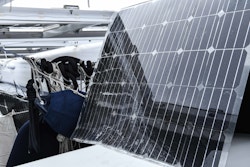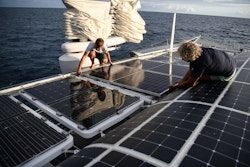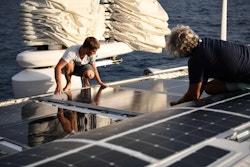Recycling solar panels: a major challenge
The development of renewable energy sources - in case we missed it during COP26’s week - is one of our trump cards for decarbonizing our energy systems and reaching the notorious net zero goals. In particular, the solar industry is booming: solar panels are more and more deployed worldwide and their cost is dropping fast, becoming competitive even with fossil fuels markets and unleashing the full economic potential of such technologies.
But what about the various components of solar panels? Can we easily recycle them? Let’s have a quick overview with Beatrice Cordiano, our energy and sustainability expert.

Cleaning solar panels in the Pacific
The numbers make it clear: the potential of solar energy is high
In 2019, the global electrical energy consumption was 65 PWh* (1 PWh = 1 million GWh), of which only 0,7 PWh (roughly 1%) came from solar.
This is such a tiny value if we consider that, according to an estimate of Solargis -the solar energy consultancy- using current technologies in suitable locations worldwide we could technically generate over 5800 PWh every year from photovoltaics alone: more than 8000 times as much!
To put these data in perspective: we do have a resource -the sun- which is potentially able to generate in just one year the same energy that could be produced by remaining fossil fuels reserves in the 100 coming years.
Despite the huge gap between technical potential and actual energy generation, which is among other things due to economic and political reasons, the growth potential for this technology is still vast and the numbers say it clearly.
An environmental challenge yet to transform into opportunity
This is incredibly good news for the world’s climate and economy, but the increasing number of panels being installed worldwide will also inevitably result in a huge amount of electronic waste in the coming years.
Today the life expectancy of a solar panel is around 25 to 30 years, nevertheless many of them are decommissioned way before because they can be damaged, they can break or they can simply degrade and become less efficient, making it unfeasible to produce energy at acceptable levels.
To give you some numbers : 43500 to 250000 tonnes of global PV waste are estimated to have been produced at the end of 2016, this represented less than 0,6% of the total panels installed then (4 million tonnes). Yet by 2050, annual PV waste streams are expected to reach 5,5-6 million tonnes -roughly equivalent to the volume of new installed PV modules- making the cumulative PV waste hit 60 to 78 million tonnes.
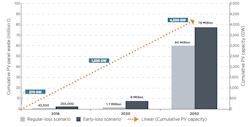
IRENA and IEA-PVPS (2016), “End-of-Life Management: Solar Photovoltaic Panels”
As with every manufactured product, letting the modules end up in landfills is hardly environmentally friendly: materials which are harmful not only to the environment but also to human health can leach out if solar cells are not disposed properly or recycled. This is worrying and might raise some doubts about the sustainability of such a cheap and green technology but depending on how we deal with this issue and following the ‘three Rs’ (Reduce, Reuse and Recycle) criterion, PV end-of-life management can represent a great opportunity.
The 3 Rs of sustainable waste management: Reduce, Reuse, Recycle
Technology is making giant leaps thanks to research and development and photovoltaic modules, both crystalline silicon and thin-film types, not only will become increasingly performant but also will require considerably less raw materials. Here is where reducing can play a role in helping improve their recyclability and enhance the components’ recovery potential.
Moreover, early failures are a common issue, but they must not be a reason to dismantle and dump the modules. Reuse is the simplest and cheapest way to face this problem. Second-hand repaired and refurbished PV modules can still be resold at a reduced price in low-income markets and find their way to small applications such as e-bike charging stations, highway electronic signs and off-grid systems where very high efficiencies are not that essential.
Although reducing and reusing represent two valid alternatives, researcher often highlight recycling as the preferred option.
Photovoltaic panels are complex pieces of technology which require raw resources to be built and when they are left to die in dumps many valuable materials are wasted. To make it simple, we can imagine a PV module as an electronic sandwich, whose filling is a thin layer of silicon cells which convert light into electricity. This filling is assembled, protected and insulated by polymers and glass sheets and incapsulated within an aluminium frame, equipped with a box containing all the wiring needed to transport the produced electricity.
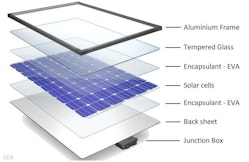
The 6 main components used in the construction of a solar panel
So many materials make the recycling process a bit trickier. Nevertheless, once disassembled, most of these components (glass, wiring, metal) can easily be recycled on their own and then reused. Silicon cells on the contrary are a different story and need to undergo different treatments (mechanical, thermal, chemical) depending on the type of solar panel to recover the valuable metals therein contained. Notwithstanding the difficulty of the process, today more than 90% -in certain cases up to 95%- of a solar panel can be recycled and that’s a stunning percentage. In short, solar panels can indeed be recycled.
Regulations, often a limit
Solar panel recycling is unfortunately not very diffused yet: there’s a lack of harmonised regulations, waste management infrastructures and coordination between the energy and waste sectors that must be addressed in a circular economy perspective.
At present, only the European Union has adopted PV-specific waste regulations -the EU Waste Electrical and Electronic Equipment (WEEE) Directive- according to which solar panels manufacturers are required to finance the modules’ collect and recycling. In the U.S., no such legislation exists, and only a handful of local recycling policies are in place. If we add the fact that the overall process is still quite costly and in countries that allow it, it is way cheaper to trash a PV module in a landfill, it becomes inevitably hard to improve the still low recycling rates.
Nevertheless, if practices and techniques are enhanced and solar panels’ most valuable components -namely silicon and silver- can be efficiently separated and purified, the cost-to-revenue ratio could get significantly better.
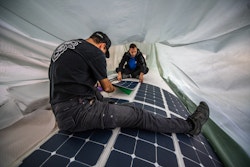
Technical stopover in 2019
Solar market is in continuous expansion and recycling processes will play a more and more important role in the following years, creating new jobs and boosting our economies. According to the International Renewable Agency (IRENA), the recycling industry of solar panels could even be worth $15 billion by the year 2050.
Solar waste is something that needs to be addressed: besides environmental protection benefits, by recycling PV panels we can alleviate supply chain constraints, limiting the depletion of available important materials and keeping on using them in the solar industry, thus further lowering the cost of solar.
Solutions are there, they are possible and they are waiting for us to implement them. Keeping e-waste out of dumps and reducing the material footprint of our economies is essential to ensure that renewable technologies are sustainable in life, as well as in death. Shifting to renewable energy is never an easy reality and for this reason, a serious strategy for transitioning into a circular economy is vital, and the sooner the better.
* NOTE: which translates in a global primary energy demand of 162 PWh (1 PWh = 1 million GWh). The difference between primary and electrical energy demand is due to conversion losses. Primary energy is the energy embodied in raw fuels, which has not yet been converted to another form of energy, electricity for instance. In the case of fossil fuels this energy is available as thermal energy and when we transform it into electrical or mechanical energy we have conversion losses. This is why from reported values of 162 PWh we fall to 65 PWh.
To go further
End-of-Life Management : Solar Photovoltaics Panels - International Renewable Energy Agency (IRENA), 2016
The sky's the limit: Solar and wind energy potential is 100 times as much as global energy demand - Carbon Tracker Initiative, 2021
Article Décrypter l'énergies: Les panneaux photovoltaiques sont-ils recyclables ?.
Video PV CYCLE: Recycling of silicon based PV modules
Downloads
- Solar and wind energy potential is 100 times as much as global energy demand - Sky the limit report Apr21 2.1 MB, PDF Download
- IRENA IEAPVPS - End of Life Solar PV Panels 2016 4.9 MB, PDF Download
